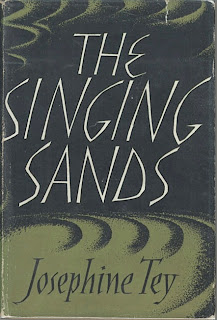 |
| Taklamakan Desert, Khotan |
Joseph Offord Musical Sand in China published in
Nature, Volume 95, Issue 2368, pp. 65-66 (1915).
Among the immense mass of ancient Chinese records and manuscripts brought back from the buried cities and caves of ancient Khotan, in Central Asia, and now stored in the British Museum, is one called the Tun-Huang-Lu, a topographical description of part of Khotan itself. This little geography was written in the time of the Tang dynasty, in the seventh century, but probably contains matter from earlier authors.
 Among the specially interesting natural phenomena of the country described in the Tun-Huang-Lu is a large sandhill, which at certain times gave forth strange noises, so much so that a temple in its vicinity was entitled the “Thunder Sound Temple.'
Among the specially interesting natural phenomena of the country described in the Tun-Huang-Lu is a large sandhill, which at certain times gave forth strange noises, so much so that a temple in its vicinity was entitled the “Thunder Sound Temple.'
The geographer, speaking specially of the sandhill, says:-"The hill of sounding sand stretches 80 li east and west and 40 li north and south. It reaches a height of 500 ft. The whole mass is entirely constituted of pure sand. In the height of summer the sand gives out sounds of itself, and if trodden by men or horses, the noise is heard 10 li away. at festivals people clamber up and rush down again in a body, which causes the sand to give a loud rumbling sound like thunder.Yet when you look at it next morning the hill is just as steep as before."
Mr Lionel Giles, from whose translations of the Tun-Huang-Lu these extracts are made, mentions that this sounding sandhill is referred to in another old Chinese book, the Wu Tai Shih.
Found reprinted in Strange Planet, A Sourcebook of Unusual Geological Facts (Sourcebook Project Maryland 1975). Compiled by William Corliss, this is from Volume E-1. From the amazing library of Jeremy Beadle MBE (1948 -2008) British entertainer, television star, hoaxer, quizmaster, book collector and philanthropist.The cave from where this mass of ancient Chinese records came is mentioned at Bookride. It was discovered in 1907 by Sir Aurel Stein -author of many valuable travel books including Sand Buried Ruins of Khotan.
Corliss cover many othe 'musical sands' including the 'Singing Beach' at Manchester, Massachusets and the 'Singing Sands' at Eigg in NW Scotland referred to in Josephine Tey's 1952 detective novel of the same name. In the Khotan caves among the books (actually a 16 foot printed scroll) was Gautama Buddha's Diamond Sutra ("The Sutra of the Perfection of Wisdom of the Diamond that Cuts Through Illusion") the earliest known (868 AD) dated printed book in the world and of inestimable value.

